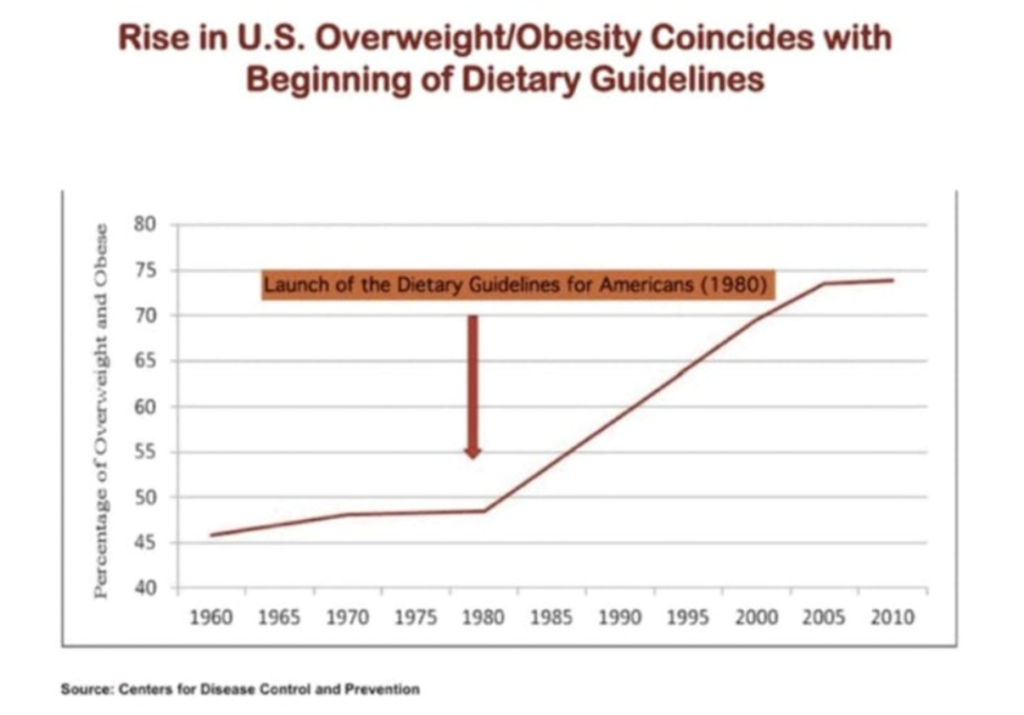The food pyramid has utterly destroyed the way Americans perceive their food.
The result of this failure can be seen all around us. The American obesity rate has been steadily climbing since the inception of dietary guidelines, and it’s starting to raise questions about what we’re being told to eat and how it’s affecting our bodies.

If you want to remain healthy and Stay Off My Operating Table®, you need to maintain your metabolic health. That means ignoring bad dietary guidelines and eating whole, real food.
But modern food companies and so-called ‘unbiased’ studies make this harder and harder to do. What does it mean to eat whole real foods, and how do you separate fact from fiction?
Let’s start with the basics.
What is whole real food?
Real food is exactly what you think it is: any food that comes from the ground or is raised on the ground. Carrots, almonds, apples, and steak are all examples of real food.
But adding ‘whole’ to the phrase ‘real food’ changes this definition slightly. Because even though french fries can technically be ‘real’ food, made with potatoes and oil, they’re certainly not whole — if you buy pre-made french fries, you can be sure they’ve been modified beyond their natural state and have become a processed food.
The term ‘processed food’ might make you think of cereals or canned pork, but in truth, many of the foods we eat can be considered ‘processed.’
For example, a stew with meat and carrots has been processed via cutting and boiling, but not to the same extent as pizza, hamburger buns, or low-fat yogurt. The more processed something is, the fewer nutrients it contains, and the less it can power your body and support your metabolic health. This is why it’s more accurate to distinguish between normal processing, which can include making cheese, and ultra-processing, which refers to most things you buy in a box or bag with a list of unpronounceable ingredients.
And the real cost of processed food is exceedingly high. Not only can it lead to cognitive decline, but it’s been linked numerous times to ovarian cancer, obesity, and all-cause mortality.
To summarize: ‘whole, real foods’ are as unchanged as possible from their original forms. If you can grow it, feed it, or pick it from a farm, it’s a whole, real food.
That being said, there’s some controversy surrounding this definition — particularly when it comes to grain. Let’s pause here a moment to address a common question:
Do grains count as whole real food?
This depends on a number of factors. But if you want a real answer, you need to start with science.
The American food pyramid lists grain as an important food group. But as we know, government food guidelines don’t have a flawless track record. Their suggested intake of six servings per day (the equivalent of three sandwiches) seems to support the carbohydrate-driven food industry.
From a scientific standpoint, we know that carbohydrates like grain are the only food constituent linked with an increase in blood sugar. Increased blood sugar is frequently associated with heart problems and chronic illness, including heart attacks. You need only to look at our spiking rate of chronic diagnoses to see how grain-heavy food guidelines are affecting this.
However, whole grains do appear to have a smaller impact on our hearts than processed grains. There is evidence to suggest foods like barley and quinoa have a lower glycemic index than rice and flour, although they still impact blood glucose more than other foods.
To answer the question: unprocessed and unrefined grains do count as whole, real food. However, I still wouldn’t recommend grains as a large part of your diet. You should aim for moderation and minimization if possible.
How to eat real food
There’s really no such thing as a single real food diet plan — eating metabolically healthy with whole, real food is extremely adaptable to your preferences. However, I understand it may be easier to get started if you have a set of guidelines to follow.
Science suggests:
- Avoiding foods or ingredients that qualify as ultra-processed. Seed oils, frozen dinners, and Oreos are a few examples to avoid at all costs. Instead, try to select foods closely resembling their natural forms and avoid ‘healthy’ processed alternatives created by conflicts of interest.
- Picking varieties of certain foods that are less processed than others. Honey, for example, is usually sold in a pasteurized form and may even contain added sugars. Raw honey can be purchased for a similar price while providing additional nutrients not found in processed varieties.
- Cooking at home as often as possible to monitor what goes into your body. If you can, try shopping from local farmers’ markets or community co-op centers. Focus on animal protein, good fats, and leafy greens. If you’re often busy and pressed for time, try making a big batch of food and storing individual servings in your freezer.
There is simply no alternative to whole, real foods — not when it comes to your metabolic health. The body yearns for nutrients that are unaltered and unprocessed, and will thank you for your efforts with better energy and a healthier metabolism. The sooner you change your dietary habits, the sooner you can reclaim your health.
If you have additional questions about whole, real foods, you’re welcome to ask me directly during my monthly Q&A. The Gold Metabolic Health Coaching plan also comes with a one-on-one metabolic health coach and free access to all my health coaching classes.
